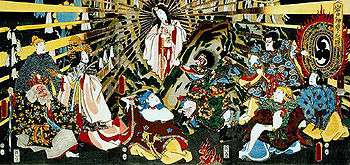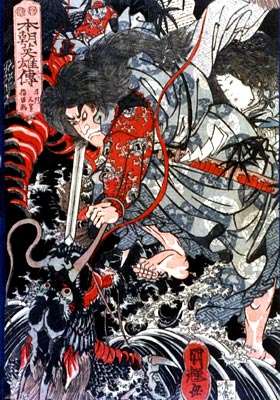Amaterasu

Amaterasu (天照), Amaterasu-ōmikami (天照大神/天照大御神/天照皇大神) or Ōhirume-no-muchi-no-kami (大日孁貴神) is a part of the Japanese myth cycle and also a major deity of the Shinto religion. She is seen as the goddess of the sun, but also of the universe. The name Amaterasu derived from Amateru meaning "shining in heaven." The meaning of her whole name, Amaterasu-ōmikami, is "the great august kami (god) who shines in the heaven".[N 1] According to the Kojiki and Nihon Shoki in Japanese mythology, the Emperors of Japan are considered to be direct descendants of Amaterasu.
History
Amaterasu appears to be the Japanese expression of a historical pan-Asiatic solar goddess. Several similarities have been noticed between the Japanese solar goddess and the Korean solar goddess Hae-nim, particularly in regards to shamanistic worship, utilising the same symbols and practices. Another possible expression is the Chinese Xihe. Though historically probably venerated highly, only in Japan did this deity find continuous worship as a central figure, as elsewhere several newer religious movements such as Buddhism and Taoism discouraged the veneration of solar goddesses.[2]
The oldest tales of Amaterasu come from the ca. 712 A.D. Kojiki and ca. 720 A.D. Nihon Shoki, the oldest records of Japanese history. In Japanese mythology, Amaterasu, the goddess of the sun, is the sister of Susanoo, the god of storms and the sea, and of Tsukuyomi, the god of the moon. It was written that Amaterasu had painted the landscape with her siblings to create ancient Japan.[3] All three were born from Izanagi when he was purifying himself after entering Yomi, the underworld, after failing to save Izanami. Amaterasu was born when Izanagi washed out his left eye, Tsukuyomi was born from the washing of the right eye, and Susanoo from the washing of the nose.
She became the ruler of the sun and the heavens along with her brother, Tsukuyomi, the god of the moon and ruler of the night. Originally, Amaterasu shared the sky with Tsukuyomi, her husband and brother until, out of disgust, he killed the goddess of food, Uke Mochi, when she pulled "food from her rectum, nose, and mouth".[4] This killing upset Amaterasu causing her to label Tsukuyomi an evil god and split away from him; separating night from day.
The texts also tell of a long-standing rivalry between Amaterasu and her other brother, Susanoo. When he was to leave Heaven by orders of Izanagi, he went to bid his sister goodbye. Amaterasu was suspicious, but when Susanoo proposed a challenge to prove his sincerity, she accepted. Each of them took an object of the other's and from it birthed gods and goddesses. Amaterasu birthed three women from Susanoo's sword while he birthed five men from her necklace. Claiming the gods were hers because they were born of her necklace, and the goddesses were his, she decided that she had won the challenge, as his item produced women. The two were content for a time, but her brother became restless and went on a rampage, destroying Amaterasu's rice fields, hurling a flayed pony at her loom, and killing one of her attendants in a fit of rage. Amaterasu, who was in fury and grief, hid inside the Ama-no-Iwato ("heavenly rock cave"), thus effectively hiding the sun for a long period of time. Though she was persuaded to leave the cave, Susanoo was punished by being banished from Heaven. Both later amended their conflict when Susanoo gave her the Kusanagi-no-Tsurugi sword as a reconciliation gift.
According to legend, Amaterasu bequeathed to her descendant Ninigi: the mirror, Yata no Kagami; the jewel, Yasakani no Magatama; and the sword, Kusanagi-no-Tsurugi. This sacred mirror, jewel, and sword collectively became the three Imperial Regalia of Japan.
Worship
The Ise Shrine located in Ise, Honshū, Japan houses the inner shrine, Naiku, dedicated to Amaterasu. Her sacred mirror, Yata no Kagami, is said to be kept at this shrine as one of the Imperial Regalia of Japan. At this shrine, a ceremony known as Shikinen Sengu is held every 20 years to honor Amaterasu. The main shrine buildings are destroyed and rebuilt at a location adjacent to the site. New clothing and food is then offered to the goddess. This practice is a part of the Shinto faith and has been practised since the year 690.
The worship of Amaterasu to the exclusion of other kami has been described as "the cult of the sun".[5] This phrase can also refer to the early pre-archipelagoan worship of the sun itself.[5]
In popular culture
- In Ōkami, Amaterasu is the protagonist, in the form of a wolf.
- In Tsubasa: Reservoir Chronicle Amaterasu is the older sister of Princess Tomoyo whose title is Tsukuyomi.
- In the Naruto manga series, the Uchiha clan, upon activating the Mangekyō Sharingan, is capable of an inextinguishable flame-based technique named Amaterasu, along with other techniques named after Japanese deities, such as Tsukuyomi. The technique is so potent that it burns anything and everything into nothingness, including real flames. The flame can only be extinguished by the user at will. However, overusing the technique with the normal results in bleeding of the eye or even permanent blindness, unless the Eternal Mangekyō Sharingan is obtained.
- In Maga-Tsuki Amaterasu is the sister of Orihime.
- In Stargate SG-1, Amaterasu is a Goa'uld System Lord in the 2004 season 8 episodes "New Order, part 1" and "New Order, part 2."
- In the comic book series The Wicked + The Divine, Amaterasu is one of twelve gods who reincarnate every 90 years only to die within two years.
- In the video game Persona 4, Amaterasu is the Fire-based Ultimate Persona of Yukiko Amagi, and is depicted as a shiny yellow figure and has metallic chrysanthemum-like wings, wielding a katana.
- In SMITE Amaterasu is a playable character.
- In the MMORPG The Secret World Rockabilly enthusiast and leader of The Pagans, Ricky Pagan, speaks of his personal holy trinity: Gaia, Amaterasu, and Elvis before sending you on a mission.[6]
- In Craig Johnson's Longmire series of books, 2016, An Obvious Fact, Amaterasu is the name of a young Japanese woman known to a retired surgeon and Walt Longmire; her name is translated as Shining Over Heaven.
See also
- Amaterasu in popular culture
- Japanese mythology
- Himiko
- Sól
- Zalmoxis
- Vairocana
- Surya, a Hindu solar deity
Notes
| Look up amaterasu in Wiktionary, the free dictionary. |
References
- ↑ Akira Matsumura, ed. (1995). Daijirin (in Japanese) (2nd ed.). Sanseido Books. ISBN 978-4385139005.
- ↑ Jacques H. Kamstra, Encounter Or Syncretism: The Initial Growth of Japanese Buddhism
- ↑ Wallin, edited by Anne Buttimer, Luke (1999). Nature and Identity in Cross-Cultural Perspective. Dordrecht: Springer Netherlands. ISBN 9789401723923.
- ↑ Roberts, Jeremy (2010). Japanese Mythology A To Z (PDF) (2nd ed.). New York: Chelsea House Publishers. ISBN 978-1604134353.
- 1 2 Wheeler, Post (1952). The Sacred Scriptures of the Japanese. New York: Henry Schuman. pp. 393–395. ISBN 978-1425487874.
- ↑ https://www.youtube.com/watch?v=FYbw2sXXV4k

